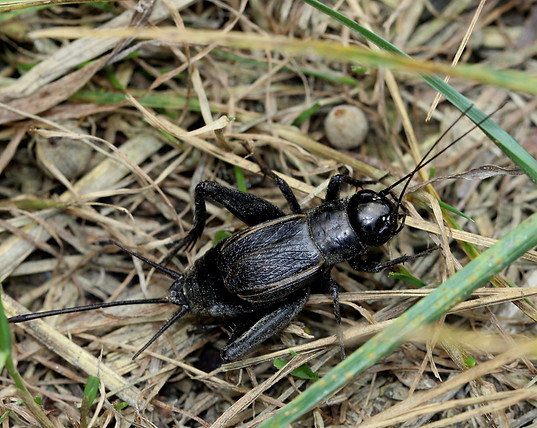Spring Field Cricket

Spring Field Cricket: (Gryllus veletis)
Occurrence
Uncommon to regionally common. Less common than the Fall Field Cricket. May into early July.
Habitat
Lake shore and dry or sandy soil. They hide in clumps of grass and under leaves. I also hear them in vegetation near railroad tracks; perhaps they like the warm, dry, sunny, relatively open location. They are very difficult to locate, as they sing at night and hide very effectively. The beach dwellers are the easiest to spot.
Range
Occasional throughout our region and more common near Lake Erie
Physical description
Large, dark brown to black cricket with a large, round head. They are almost an inch long. Females have a long, straight ovipositor that some people mistake for a “stinger.”


Song:
A continuous “chirp-chirp-chirp” that is somewhat rhythmic. The song sounds identical to that of the Fall Field Cricket. They sing in the afternoon but especially at night.

Lake Erie Bluffs Spring Field Cricket singing
Listen to this recording from Lake Erie Bluffs of Spring Field Crickets singing on the sandy bluff after dark. Listen, too, to their context. Do you heard the toads in the distance? That tells you this had to be a Spring Field Cricket recording. And do you hear the train? Field Crickets are often near train tracks, and particularly those that are on the old lake plain near Lake Erie.
General description and context:
Although they are significantly more substantial than ground crickets, they can still be difficult to find because they hide under vegetation and in various holes and crevices. They are certainly easy to hear, however, and their springtime chirping is a cheerful, welcome beginning of singing insect season.
Spring Field Crickets overwinter as nymphs, which is why they begin singing so early. Their season begins in early May and is over by about mid-July. There is typically a pause of a couple of weeks before the look-alike and sound-alike Fall Field crickets begin their season.
Similar species:
The look-alike, sound-alike Fall Field Cricket matures a couple of weeks after the Spring Field Crickets have disappeared. Spring Field Crickets are larger and more substantial than any of the ground crickets, and the earliest ground crickets do not mature until the second week of July at the earliest. Identification, therefore, is fairly straightforward. If you hear field crickets in mid to later July, however, you may not know which species you're hearing.
Field observation:
Although I’d read about the nymphs overwintering, this became more real to me when I looked under a log at the edge of the Lake Erie beach at Mentor Lagoons in late fall and found nymphs underneath!
Listening in Nature post:
http://listeninginnature.blogspot.com/2013/06/singing-insect-prelude-first-insect.html
Songs of Insects:
http://songsofinsects.com/crickets/spring-and-fall-field-crickets
